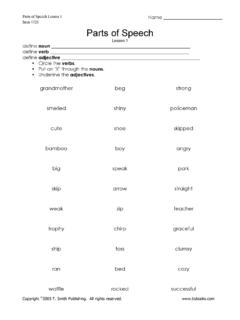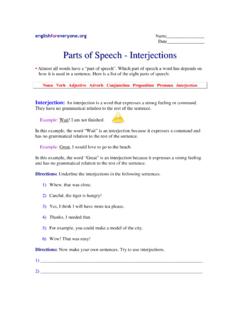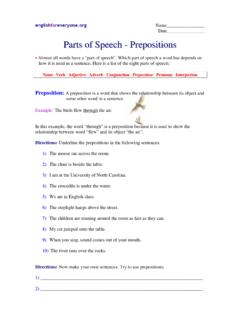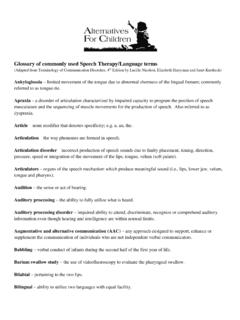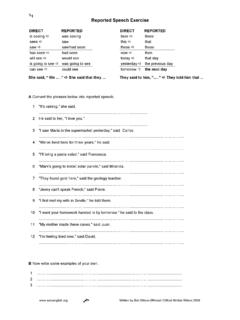Transcription of Speech Therapy Techniques - Handy Handouts
1 Speech Therapy Techniques : For Errors related to Cleft Palate or Velopharyngeal Dysfunction Ann W. Kummer, PhD, CCC-SLP Cincinnati Children s Center Velopharyngeal dysfunction (VPD) refers to a condition where the velopharyngeal valve does not close consistently and completely during the production of oral sounds. There are three types of VPD: Velopharyngeal insufficiency (VPI) is used to describe an anatomical or structural defect that prevents adequate velopharyngeal closure. Velopharyngeal insufficiency is the most common type of VPD because it includes a short or abnormal velum, which occurs in children with a history of cleft palate or submucous cleft. Velopharyngeal incompetence (VPI) refers to a neurophysiological disorder which results in poor movement of the velopharyngeal structures. This is common in individuals with dysarthria due to cortical damage or velar paresis due to cranial nerve damage. Velopharyngeal mislearning refers to a lack of velopharyngeal closure on certain sounds due to the use of sounds in the pharynx as a substitution for certain oral sounds.
2 Children with VPI may demonstrate hypernasality (too much sound in the nasal cavity), nasal air emission (leakage of air during consonant production) and compensatory articulation productions (abnormal articulation productions in the pharynx to compensate for a lack of oral air pressure due to VPI). Children with velopharyngeal mislearning may produce pharyngeal sounds as a substitute for oral sounds (even without a history of VPI). This causes nasal emission due to the placement of production. Differential diagnosis is very important in order to determine appropriate treatment. VPI (both types) requires physical manage ( , surgery or a prosthetic device if surgery is not an option. Velopharyngeal mislearning (including the continual use of compensatory productions after surgical correction of VPI) requires Speech Therapy . Indications for Speech Therapy Speech Therapy cannot change abnormal structure and therefore, cannot correct hypernasality or nasal emission due to VPI even if there is only a small gap!)
3 VPI requires physical management (surgery, or a prosthetic device if surgery is not an option). Speech Therapy can correct placement errors (abnormal function) that cause nasal emission or hypernasality, including the following: o Compensatory articulation productions secondary to VPI that continue to cause nasal emission after the VPI repair because they are produced in the pharynx o Misarticulations that cause phoneme-specific nasal emission or hypernasality o Hypernasality or variable resonance due to apraxia Speech Therapy Techniques Ann W. Kummer, PhD 2 o Hypernasality or nasal emission following surgical correction. This is because changing structure does not change function. The child may need to learn to use the corrected velopharyngeal valve through auditory feedback. The following are specific Therapy Techniques that have been effective at Cincinnati Children s. Speech Therapy with Uncorrected VPI If the child has VPI but surgical correction is being delayed due to airway concerns, work can still be done on articulation placement.
4 However, articulation placement is very difficult to learn without adequate oral air pressure. Therefore, a nose plug should be used in Therapy , and worn at home during practice and play as much as possible. Speech Therapy after VPI surgery Following surgery, the child may continue to have hypernasality or nasal emission, despite normal articulation. This is because changing structure does not change function. The child may need to learn how to use the new structure through auditory feedback. Auditory stimulation and imitation is the natural way to learn Speech sound production and VP function. Work on the Speech sounds in repetitive syllables with different vowels ( , pa, pa, pa, pa; pee, pee, pee, pee, pee, etc.). Start with the consonants in Group 1. (See groups below.) Make sure the child is mostly successful in eliminating nasality (as hear through a tube) before moving to Group 2, and later to Group 3. Group 1: /p, t, k/ Group 2: /b, d, g/ Group 3: /f, s, , , / Using a listening tube (even a bending straw), have the child put one end of the tube in the entrance of a nostril and the other end near his ear.
5 When nasality occurs, it is heard loudly through the tube. Ask the child to try to reduce or eliminate the sound coming through the tube as he produces oral sounds and then words. Put the end of the listening tube in the front of the child s mouth and the other end at the child s ear. Have the child try to increase the oral pressure on oral sounds to hear it loudly through the tube. Listening Tube: Feedback for nasality Listening Tube: Feedback for oral pressure Speech Therapy Techniques Ann W. Kummer, PhD 3 Oral & Nasal Listener1 (ONL) The Oral & Nasal Listener1 (ONL) is more effective than a simple tube or straw because it allows both the Speech -language pathologist (SLP) and the child to hear the sound at the same time and at the same volume. This makes it much easier to give appropriate feedback to the child. The ONL is also very effective for home practice because it allows the parent and the child to easily distinguish normal from abnormal productions.
6 Put the end of the tube in the child s nose for feedback about nasality. Put the funnel of the ONL in front of the child s mouth to provide feedback about oral resonance, oral airflow, and oral pressure. Oral & Nasal Listener Oral & Nasal Listener Feedback regarding nasality Feedback regarding oral pressure and articulation Nasometry If available, the Nasometer2 provides excellent visual feedback of hypernasality and nasal emission. Therapy for Placement Errors After surgery for VPI, the child may continue to use compensatory productions, which result in continued nasal emission. In Therapy , begin with awareness of the abnormal production versus the target sound. Give as many clues as possible using visual, tactile and auditory feedback. In all cases described below, use a straw, listening tube, or the ONL periodically for auditory feedback. Glottal Stops A glottal stop is like a grunt sound that is co-articulated with oral sounds, particularly plosives.
7 1. Make the child aware of the glottal stop versus the target as follows: While in front of a mirror, have him watch the contraction in his neck when producing the glottal stop versus an /m/sound Have him place his hand on his neck during the productions of a glottal stop to feel the jerk versus the smooth voice onset during production of a vowel or the /m/ sound. Have him listen to the difference between the glottal stop and a /g/ sound. Speech Therapy Techniques Ann W. Kummer, PhD 4 2. Have the child produce isolated voiceless plosives without the vowel while feeling his neck or watching in a mirror. (For voiceless sounds, the glottal stop does not occur until transition to the vowel.) 3. Have the child produce the voiceless plosive /p/ and then a vowel preceded by an /h/. For example, / for /p / and for /po/. This keeps the vocal folds open during transition to the vowel and prevents the production of the glottal stop. Gradually, decrease the transition time from the consonant to the vowel until the syllable is produced without the glottal stop.
8 4. Once voiceless consonants are produced, move to voiced plosives. Have the child produce the voiced sound slowly with a breathy voice. Gradually add smooth voicing and transition to the vowel with an inserted /h/. Have the child feel his neck for feedback. Nasalized Vowels or /l Substitution Nasalized plosives or vowels can persist after surgical correction of VPI. Nasalized vowels can also occur in children with no history of VPI. This is usually due to an abnormally high posterior tongue position during production of high vowels, particularly /i/ (as in feet ). This faulty articulation placement causes phoneme-specific hypernasality. In addition, some children have phoneme-specific hypernasality due to substitution of /l. The nasal for oral sound makes connected Speech sound somewhat hypernasal. 1. Ask the child to produce a big yawn, which pushes the back of the tongue down and the velum up. Make him aware of the stretch in the back of his mouth.
9 2. Have the child coarticulate the nasalized sound (vowel or /l/) with the yawn, while feeling the stretch in the back of the mouth. 3. For auditory feedback at the same time: Have the child use a listening tube or the ONL Have the child alternately pinch and open the nose during production of the sound. Have the child try to produce the sound so that there is no difference between the two productions. Nasalized / / The final / / sound is a continuant sound that is produced by articulating the sides of the back of the tongue against the gum behind the molars. The mid portion of the tongue forms a boat-like shape through which sound enters and resonates. If the child raises the entire back of the tongue, the sound becomes an / , which is a nasal substitution for an oral sound. 1. Using your hand, show the child how the shape of the tongue forms a boat when producing final / /. Note that the back of the tongue has to touch the gums behind the back teeth.
10 2. With a tongue blade, stimulate both sides of the tongue towards the back. Then stimulate the upper gum ridge behind the molars. Tell the child that these come together for / /. 3. Ask the child to make a wide smile while backing up the boat to make the tongue touch the gums on each side. Speech Therapy Techniques Ann W. Kummer, PhD 5 4. Assist the child with posterior tongue elevation by pushing up against the base of the chin with your middle finger while squeezing his cheeks with your thumb and forefinger. If you feel his tongue push down under the chin, have him relax it so you can push it up. 5. If the child continues to raise the entire back of the tongue for / /resulting in an / /, have him close his nose during production. That will make the / /sound impossible to produce. 6. Once final / / is established, show the child how the tongue tip moves forward for initial /r/. Have the child put his hands on his face while producing the /r/.

